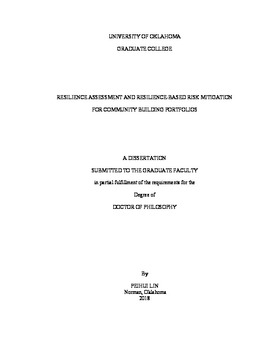| dc.description.abstract | The resilience of a community is determined by its ability to withstand and recover from disruptions due to natural or manmade hazards. While a consensus has developed in disaster-related research in recent years that community infrastructure should be designed, managed and regulated to achieve community-specific resilience goals, there is currently no integrated source of quantitative tools and measurement technologies to support risk mitigation decisions of building owners, city planners, policy makers and other community stakeholders in a coordinated and risk-informed manner.
The on-going efforts in the NIST-funded Center for Risk-based Community Resilience Planning (CRCRP) are aimed at developing a comprehensive computational platform, named IN-CORE, which integrates science-based models of community socio-economic systems and supporting interdependent physical infrastructure (i.e. building portfolios, transportation infrastructure, energy, water/wastewater, and communication networks) in several distinct modules, with an ultimate goal of supporting community risk mitigation decisions and optimizing resilience planning activities. This dissertation work provides the essential components of the IN-CORE module on Community Building Portfolio Resilience Analysis.
This work contributes to the state of the art of resilience assessment of community building portfolios in several aspects. First, a new building portfolio functionality metric (BPFM) is proposed, which is a measureable, scalable, and actionable indicator of a building portfolio’s capacity to respond and recover from a hazard event. The BPFM enables the resilience of a building portfolio to be assessed on a consistent measure at various spatial scales (e.g. parcel, block, census, zone or community) and throughout the time domain of interest (i.e. pre-event planning, immediate post-disaster response, and long-term recovery). Second, a building portfolio functionality loss estimation (BPLE) framework is developed, which provides a probabilistic and spatial loss assessment, measured by the BPFM, across an entire community immediately following a hazard event; this assessment also defines the initial post-event functionality state, which is the starting point for building portfolio recovery modeling. Third, a novel stochastic post-disaster building portfolio recovery model (BPRM) is formulated; this model characterizes the spatial and temporal evolution of a building portfolio’s recovery following a hazard event, resulting in projected recovery trajectory and recovery time of the building portfolio, as well as the spatial variation of the recovery outcome within the community. Finally, a building portfolio decision support (BPDS) framework is constructed, underlining that the resilience of a building portfolio (assessed by the BPLE and BPRM) can be enhanced to achieve risk-informed resilience goals through optimized mitigation strategies and recovery planning activities at a community scale. | en_US |
